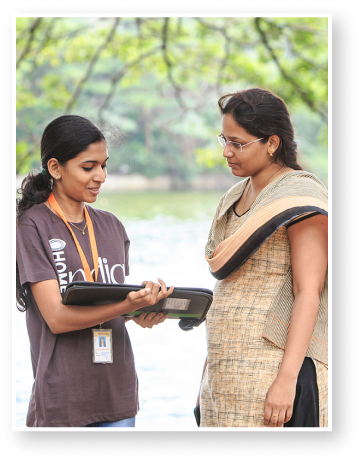“Prayati Charity Trust” is a not for a profit charity organization focusing on providing education and accommodation to underprivileged girl childre
My role



Brief
Prayati came to me with the need to design a website, which will help them market themselves and appeal to fundraisers as a friendly company.
Business goal validation workshop
Prayati was not confident about their requirement and on asking a few questions, they realized that they had not done enough brainstorming before concluding their requirement. I suggested running a goal validation workshop with them and they gracefully agreed.


Below were the out come of the workshop
Prayati’s goals
- Retain fundraisers for a longer time
- Leave the donor with a delightful experience
- Motivate donors to approach us when they wish to donate pro-actively
Prayati’s Challenges:
- Donations have been irregular and sometimes we frequently change operational goals to keep budgets on track
- Wasting a lot of money on marketing campaigns
- Fundraisers keep complaining about not being treated with respect
Based on the workshop it was clear that Prayati didn’t need a new website design but a better process in raising funds. And the team understood and agreed to this.
Understanding the ecosystem
We now started the discovery process, understanding the stakeholders and then the as-is process.
Stakeholders

Donor
The donor is a very wide role, can span through many demographics.
Generally, fundraisers approach the donor on the street and do a cold pitch.

Fundraiser
They spend more time on the street meeting donors
Some time in the office learning from managers, getting briefed, guided, and motivated.
They also make follow-up phone calls to some of the donors who promised the donation and provided a contact number.

Manager
A manager is responsible to train, guiding, and leading a group of fundraisers.
They have usually graduated with a couple of years of experience in sales-related jobs.
There are 3 managers working at present, they are divided by territory.
Various channels of fund raising
From our workshops and discussions, it was discovered that there were other forms of campaigns that we needed to learn and research before deciding which is the best to go ahead with.
- Street canvassing
- Direct email campaings
- Indirect email campaings
- Phone call campaings
- Media campaings
The service design process

Primary research
- Contextual inquiry
- User interviews
Contextual inquiry
Observed multiple people from each user type to collect the untold story.



User interviews
After observing users while they performed their responsibilities, we had to question them to get answers for some of the behaviors that needed the reasoning. So we conducted user interviews.

Secondary research
I considered doing secondary research to learn which model of campaign fetches maximum success so that we can focus our efforts on building that process first.
Analyzing the best campaigning method
Observed multiple people from each user type to collect the untold story.
| A: Street canvassing |
| B: Telephonic canvassing |
| C: Media campaign |
| D: Web-based campaign |
| E: Email-based campaign |
| A | B | C | D | E | |
| Quick turnaround | ✔ | ✔ | |||
| Most learnable | ✔ | ||||
| In-person 1:1 engagement | ✔ | ||||
| Control over content and communication | ✔ | ✔ | ✔ | ||
| Unified messaging and branding consistency | ✔ | ✔ | ✔ | ||
| Mass communication to prospective donors | ✔ | ✔ | ✔ | ||
| Quick response | ✔ | ✔ | |||
| Follow-ups | ✔ | ✔ | |||
| Emotionally connect with donors | ✔ | ||||
| Most conversions | ✔ | ||||
| Donor privacy | ✔ | ✔ | ✔ | ||
| Secured handling of individual offers and coupons | ✔ | ✔ | ✔ | ||
| Easy online and instant payment | ✔ | ✔ | ✔ | ||
| Most engaging | ✔ | ✔ | |||
| Less annoyance to the donors | ✔ |
Based on the above exercise we had a clear indication that Street canvassing is the most rewarding for both donors and the needy. So we decided to explore and create a process for street canvassing.
Research insights
- Research analysis
- Persona
- Responsibility map
- Learnings
- Challenges
- Findings
Cluster analysis
After the contextual inquiry and interview, we needed to analyze the data collected. Whiteboarding data clustering is the handiest way of analyzing interview data.


Persona
A persona represents the real user. In any stage of the project life cycle, everyone in the team must consider working towards the goals and aspirations of the persona.
Donor

Fundraiser

Responsibility map
As-is mapping of the responsibilities of each stakeholder to understand the ecosystem

Learnings
- I am sympathetic
A lot of the time, I am sympathetic to whatever cause they’re representing… But I’m turned off by the round-about way of getting me to commit money then and there - I know more
To be honest, it seems that sometimes I know more about the topic than they do. It seems like a racket - Give them money
They ask if I have a few minutes to talk, but they really want me to give them money - Feel manipulated
They come off as overly friendly, but it’s like I feel manipulated into talking to them, or made to feel guilty if I ignore them - For getting in your face
They work in teams and seem to have strategies for getting in your face, even when you want to avoid them
Challenges
- Reaching new donors
Street engagement direct appeal campaigns use incentives to reward the fundraising activity of reaching new donors and rely on emotional appeals and tactics to motivate those donors. - Obtrusive and disruptive to individuals
Real-time solicitation of support from individuals out on the street, through one-on-one engagement on a topic is often obtrusive and disruptive to individuals. - Designed to draw in
Engagement of individual employs strategy, imposition tactics and social expectations designed to draw in those who are not looking for an interaction.
Findings
- Trend toward online giving
Growing popularity / trend toward online giving efficient means of collecting donations and donor data easy method of donating for user - Justifiable return
Direct engagement + emotional appeal as a motivator despite overwhelming disdain of practice of street canvassing, organizations still use it because they get a justifiable return. - Emotional appeal as motivator
Incentivize giving as an alternative to emotional appeal can replace emotional appeal as a motivator. Need to find the sweet spot between “useful”, “affordable” and “responsible” (not wasteful -not crap). - Incentivization
Incentivization of fundraising activity (vs. Of giving) canvassers are paid (by agency) commission on amount collected if and after they meet a daily quota canvassing. Agency take in per donor commission from NPO (without any quota restrictions whatsoever).
Donor journey map
After data analysis, we need to give it a shape and consumable format. A user journey map is one of the best methods to understand stages in a project, personas involved, tasks, and emotions.

Solutions
Solution workshop
Conducted a workshop with stakeholders – President, accounts officer, operations head, managers and 2 fundraisers


Solution Findings
- Use face-to-face engagement to promote
Change the role of street canvasser from “disorder” to “engagement agent” remove the need for “tactics”. And emotional appeal motivates to promote and distribute with tracked commission incentives. - Redirect incentivization toward the user/donor
Establish partnerships with content providers to negotiate donations in the form of account upgrades offer upgrade rewards as incentives to donate remove quota incentivization for canvassers. - Push to online to collect, integrate and inform
Use direct engagement to create online traffic utilize online donation to capture new donor information more efficiently, integrate with database and better disseminate and share information. Encourage “code sharing” to expand new donor reach. - Provide centralized user interface to
Allow for quick and easy donation earn, apply and manage rewards integrate user content accounts.
Storyboard of the service (process) to-be
After we decided what should be improved, I created a storyboard of the service to-be so that everyone can understand

User flow (to-be)
After we discovered that we would need a web application which can be used to:
- Showcase all the campaigns
- Let user donate
- Let users track their donation
- Provide goodies to the donors and help them with information to save tax from the donation

Fund-raiser mobile app
Verdict
After multiple usability tests and shadowing users, we made a few tweaks to the app and after a month of observations, we concluded that the fund-raisers were much happier to use the app and avoided many unpleasant conversations. Conversion of prospective donors was also higher due to streamlined operations.
Comments are closed